https://cdn.athlonoutdoors.com/wp-content/uploads/sites/6/2016/01/tops-knives-vi-ax-3.jpg
One of the most iconic scenes in modern movie history was seen in The Patriot. In the scene, Benjamin Martin (Mel Gibson) brings a fighting tomahawk to bear on multiple British soldiers. He then dispatches them with extreme prejudice.
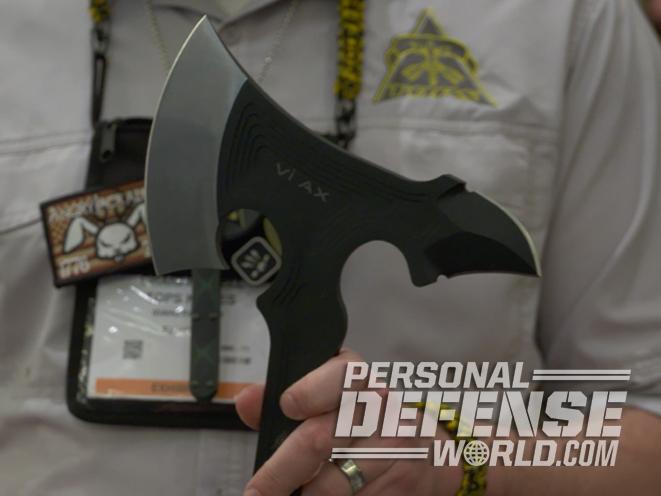
RELATED STORY
Vi Ax: The New Indestructible Ax From TOPS Knives
The Fighting Tomahawk
The tomahawk is generally believed to have been created by the Algonquians in early America. They would use stones, sharpened by a process of knapping and pecking and attach them to wooden handles, secured with strips of rawhide.
The tomahawk quickly spread from the Algonquian culture to the tribes of the South and the Great Plains. With the arrival of Europeans, the stone blades soon became metal, and the modern tomahawk was born.
The tomahawk has experienced a well-derived resurgence over the last several years as bladesmiths have begun to explore this classic weapon. Like any edged weapon, it can be an excellent tool of defense. On the same note, it takes some training to become effective with it.
One of the benefits of modern tomahawks is design. The use of high-end design and manufacturing processes has allowed us to have access to excellent close-quarter weapons. One of my favorites is the VI Axe from TOPS Knives. It is a cross between a traditional tomahawk and a fighting axe.

With all that said, let’s look at some of the fundamentals of fighting with a tomahawk.
Grip
Using a tomahawk or fighting axe allows for devastating abilities if used correctly. The first thing to consider is grip. While you may be tempted to choke up on the weapon to feel faster, you will diminish its abilities.
On a regular-sized weapon of approximately 16 to 18 inches, your grip should be set about two inches from the bottom to allow you to maximize the mass of the weapon. You will always have the ability to choke up on the grip if the situation dictates, but let’s start out with the full power of the weapon. A tomahawk or axe has a little more mass than the average knife, so a firm grip is in order.
Stance
Next on our list of things to understand is stance. Now in all reality, if you are defending your life with a tomahawk or fighting axe, there is not going to be much of a static stance. This is the same principle I teach in shooting. It looks good on paper, but it all flies out the window when the fireworks kick-off.
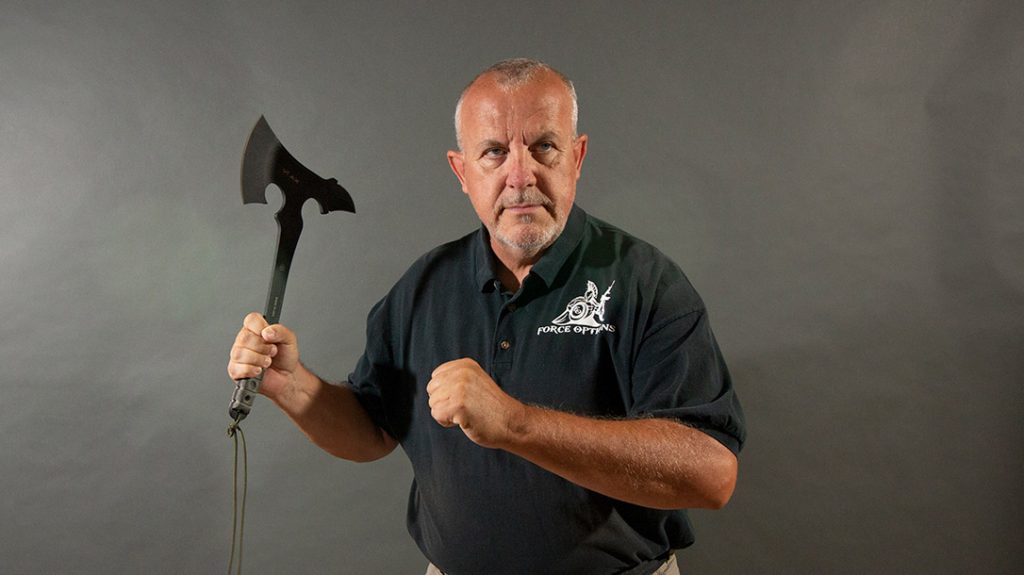
What you can do however is to maintain a fighting position. That is your support side foot forward and your dominant foot in the rear. Knees slightly bent and weight balanced evenly over your feet. You will want to be slightly on the balls of your feet to increase your speed and mobility. I call this simply a fighting stance, and it is common across pretty much every serious combat system on earth because it works well.
Another aspect of this is where you position yourself in relation to the threat. Just as I teach police officers and others, take the step to get off their centerline. Try to avoid standing directly in front of them and move about 45 degrees to the side. This forces them to turn if they intend to attack you and gives you a superior fighting position.
Chop
Now that we have a good stance and great position, we are able to strike should the need arise. Cutting with any blade takes practice, and I highly encourage you to get professional training to master it.
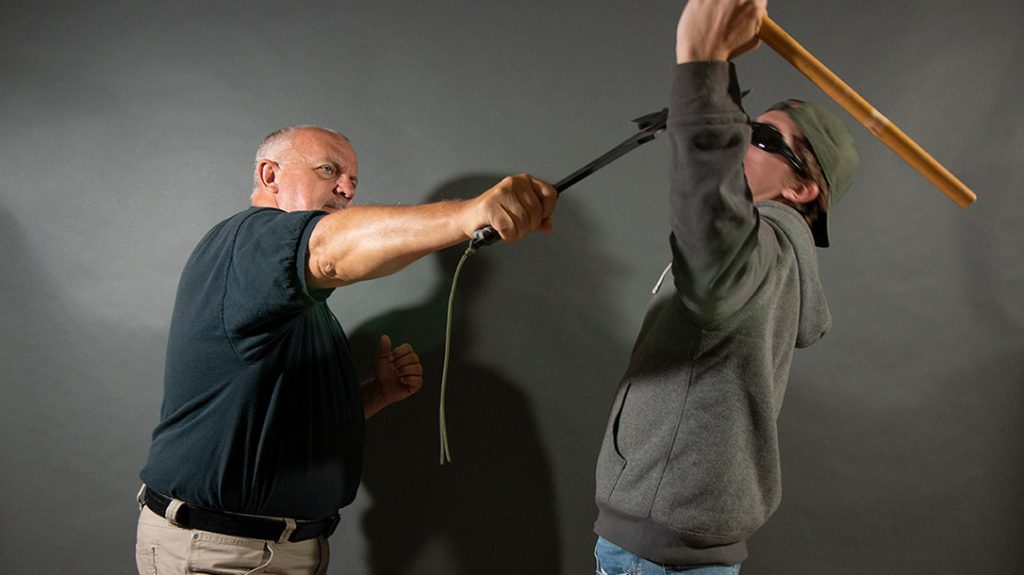
While we want to use the razor-sharp edge and mass of the weapon, we need to balance that with the type of strike we will use. As with all striking or cutting, we want to utilize our center or core. Engage the hips as you swing the cutting edge towards the target. Avoid any large wind up because our hips are going to give us the power we need. As you swing, try to focus on the tip of the edge and drive it forward.
Just like a sword, imagine you are flicking something off the tip of the blade. This will give you the best cutting stroke. As you cut, you want to follow through. Avoid stopping the motion as you meet resistance and let the blade cut through the target. Done correctly, a good cut can relieve an adversary of a limb. As you cut through the target, bring the weapon back into your center, and then prepare for another strike.
Cut
In the event space gets tight, you can still get excellent results with a tomahawk. Made correctly, the edge of these weapons is as sharp as any knife.
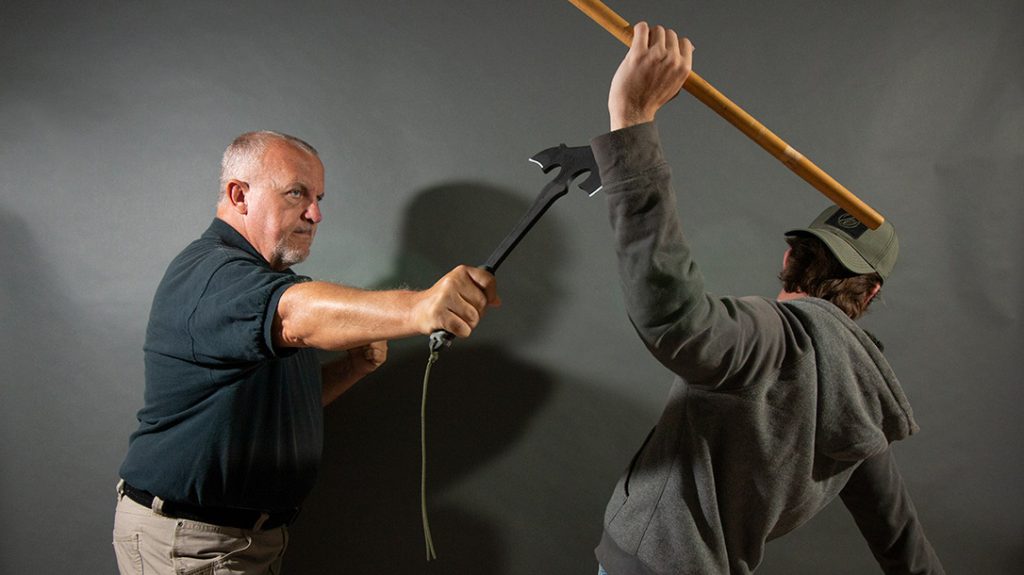
Cutting with a tomahawk is done the same way as we would with a knife. While slashing does not have the fight-stopping power of a chop, it will certainly do extensive damage. To get the most out of it, bring the weapon up into your center and slice forward and down into the target.
Our goal is to cut deep and long. We want more than just a superficial cut. While painful, these cuts rarely become fight stoppers. Just like we did with the chop, we want to have good follow-through and then reset for another cut. One cut is never enough.
Hook
One of the unique features of a tomahawk or fighting axe is its ability to hook. This allows us to move the subject if need be and position them. To execute this maneuver, drive the head of the weapon just over the area you want to hook.
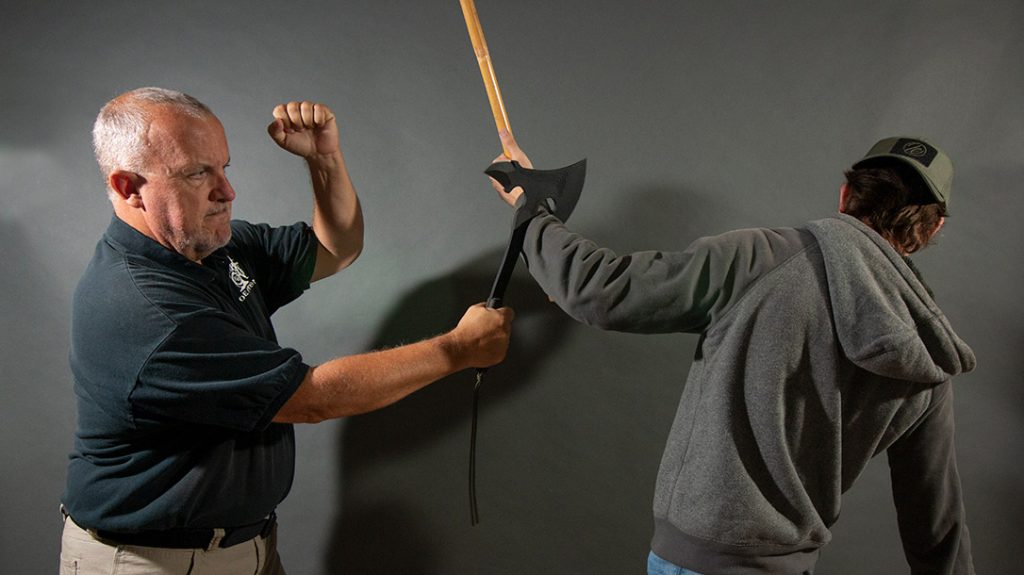
A common target is an arm or wrist. Once you are just past the target, drive the edge down as you pull back into your center. If you use your entire body in this move, you can easily move an arm or more.
The benefit of this technique is to open them up to a more effective chop or even a deep cut. Once again, following through is important.
Hammer
Many weapons in this class can also double as a club. If the situation dictates a less bloody response. Slamming the back end or even the side of the weapon onto a target such as the nose or head can get solid results.
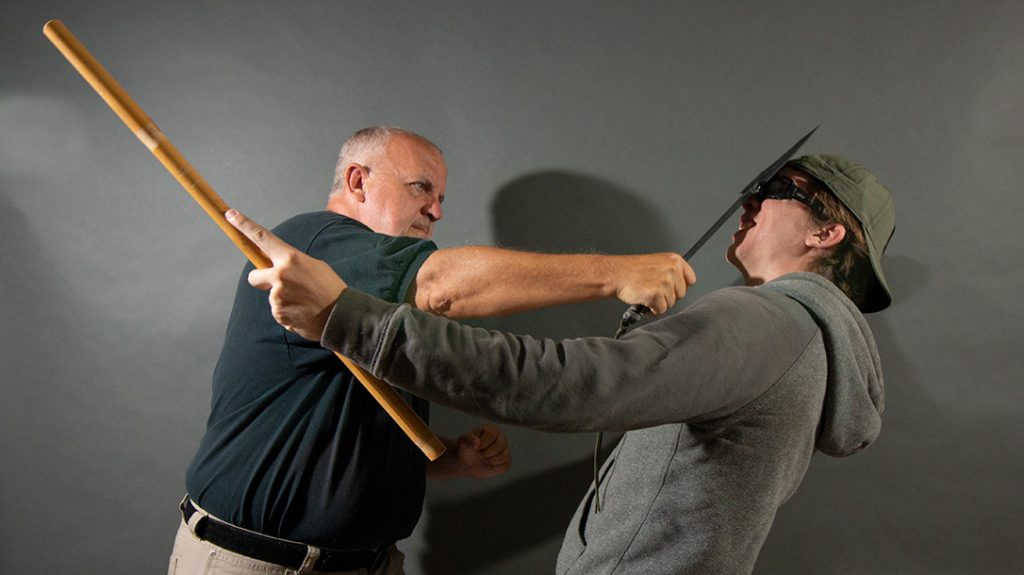
This is where you treat the weapon as if it were a hammer and the target as a nail. We want to drive the nail in with one stroke and break their will to fight. A solid piece of steel slammed into the skull can cause not only pain but mechanical dysfunction as well. Placing that strike across the bridge of the nose gives us pain once again but additionally causes the eyes to water profusely giving us a tactical advantage.
Where
Tap dancing here on the edge of too much information, I would like to talk about targeting and places to attack. Our defensive goal is to get them to break off their attack. This is done in one of two ways.
The first is that psychologically they decide they have gotten into more than they bargained for and break off their assault. The other option is that they become physically incapable of attacking you.
Regarding the latter, we want to make every cut or chop effective and productive. The human body breaks down in two ways: they mechanically can no longer function i.e., losing a limb, or they lose so much blood that they become ineffective. When we look at limb removal, the size of our weapon and skill level must be taken into account. With most tomahawks or fighting axes, fingers or even a hand can be taken off with a well-placed chop.
If we are driven to focus on blood loss, then attacks along the side of the neck will give us the best results. While cuts and chops into the thorax are certainly destructive, the time it might take them to dissuade an attacker can be drawn out if they are committed to the attack. We need them incapacitated as quickly as possible. The shorter the physical conflict, the lower the chance that you will be seriously harmed.
A Weapon of Convenience
The tomahawk or fighting axe in modern society is a weapon of convenience. Rarely do we see someone carrying this classic weapon on their belt. Along with being a fantastic weapon, it is a solid performing EDC and bugout tool. Think of it as a very sharp utility tool that has the ability to cut wood as well as people. I have encouraged the inclusion of these handy helpers in truck kits, bug-out bags, and camping loads for decades.
As I alluded to earlier, the market is now filled with a variety of options to choose from. Much like buying a handgun, take your time and find the one that fits your needs and space the best. While a five-foot battle axe will end about any fight, it is not going to fit in your Corolla very well.
As with all things in life, we need to find a balance. Once you find the one you want, seek professional training to get the most out of the newest member of your personal defense family!
This article was originally published in the Personal Defense World Gun Buyer’s Guide February/March 2022 issue. Subscription is available in print and digital editions at OutdoorGroupStore.com. Or call 1-800-284-5668, or email subscriptions@athlonmediagroup.com.
The post The Fighting Tomahawk Still Has a Place in Personal and Home Defense appeared first on Personal Defense World.
Personal Defense World